Dear Beastly Latin Team,
Salve – Hello and Welcome to our First Newsletter – On the Lion
Thank you very much for signing up to our new and (we very much hope) fun project to translate and then update the earliest medieval Latin prose bestiary. Your help will be invaluable in allowing us to spread these wonderful (and occasionally bizarre) stories about Medieval Animals and the task is a core part of the Medieval Animals Heritage in East Kent project. Thank you for joining us.
The plan is to send you a regular Newsletter (called Latinobarbus: Beastly Latin) with the next chapter in Latin (on a separate sheet). There are 38 chapters to translate, so we shall be busy bees. Each Newsletter has notes and tips (plus some gorgeous images as you can see) and the translation of the previous chapter.
We shall hold a fortnightly Zoom to discuss the translation. However, we hope that some groups might want to meet in person before the Zoom – perhaps online or down the pub or café – to work on the translation first because it’s fun to get together and there are so many ways to translate the chapters. Do please note this is not homework and there is no marking.
If you have any queries, please do get in touch, we may not have all the answers, but it will be great to speak with you,
With every good wish,
Diane and Penny
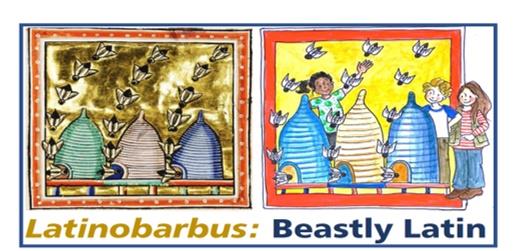
Left: Bees, Oxford Bodleian Library, Ashmole 1511, fol. 75v CC BY-NC 2.0
Right: Bees by Penny Bernard, CC BY-NC 2.0
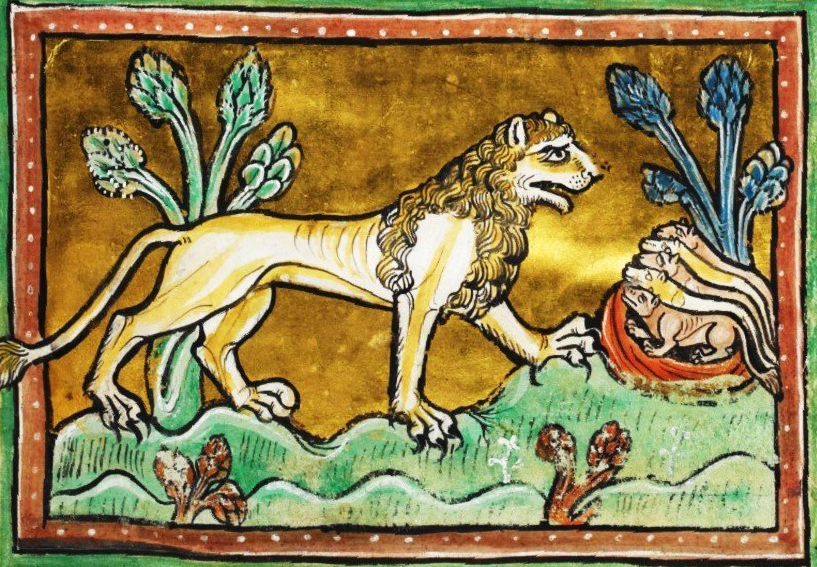
What is a bestiary or liber bestiarum?
The bestiary, as its name implies, is a book of beasts. The first of its two main sources was a book called the Physiologus (Greek for ‘The Naturalist’ – think David Attenborough in a toga) that was written about 250-300 CE (AD) probably near Alexandria in Egypt and linked to the Desert Fathers and the earliest Christian monasteries. The animal lore in the bestiary draws on classical learning, Ancient Egyptian ideas, and folklore with a very large helping of the Bible and Christian spirituality. The second book that was copied into the Physiologus to form the medieval bestiary was Book 12 of Isidore of Seville’s Etymologies, ‘On Animals.’ Isidore wrote in the early seventh century and he sought to explain animal traits (and other things) by examining the language roots of names. For example, the crocodile is named after the crocus, as its hide is yellow like the flower. The explanation helps form a stunning and memorable mental image, although crocodiles are not very yellow.
The two texts were combined probably in the ninth or tenth centuries to emphasise how animals could guide human behaviour. Although considered authoritative in the Middle Ages, the bestiary is often wildly inaccurate. However, it sometimes contains kernels of direct observation from nature, and in fairness, it was written to impart spiritual guidance rather than teach natural history.
The Latin comes from Max Friedrich Mann’s 1888 transcription by of a thirteenth-century manuscript, although this earliest form of the bestiary has never been translated. The original manuscript is now in the British Library in London (Royal MS 2 C XII) but it has not been digitized. 1 However, the Oxford Bodleian Library (OBL) has partially digitized the earliest extant Latin prose Bestiary from twelfth-century England (possibly from Canterbury), and the shelfmark is OBL Laud Misc. 247 . Do compare, if you wish, the transcription with the medieval manuscript, the first pages of the Laud manuscript are below (credit: Dr P. Stewart). 2
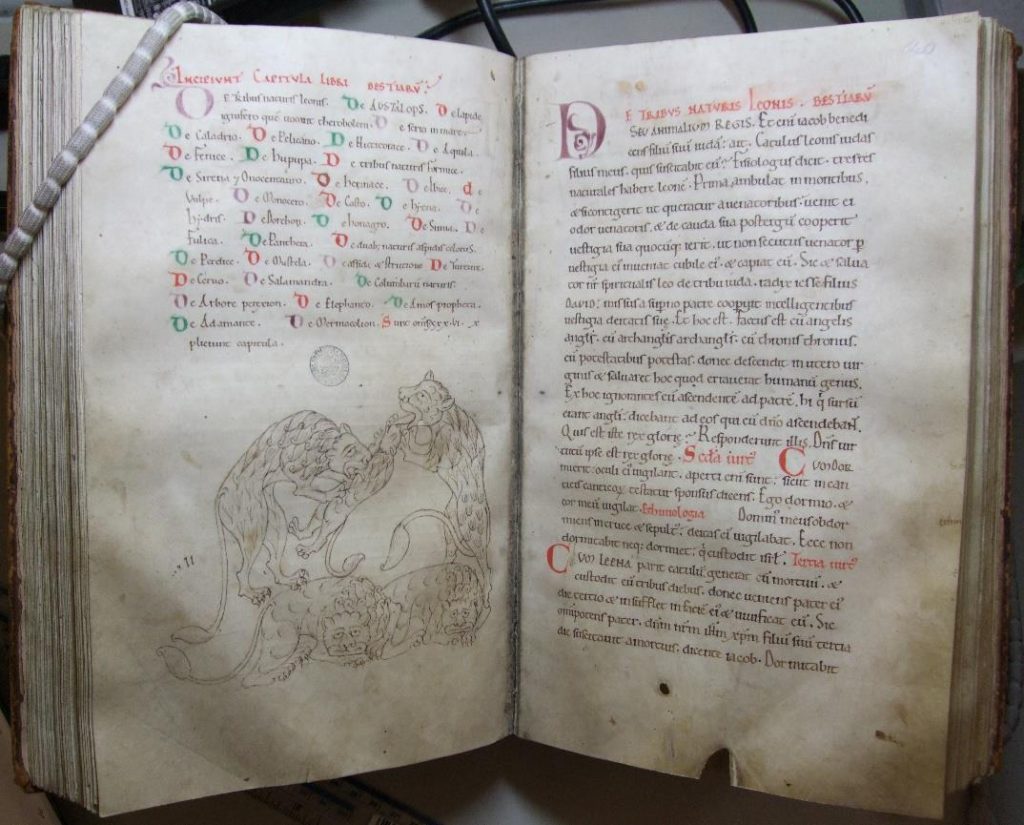
Example of a Latin First Family Bestiary Manuscript from Bodleian Library
This early twelfth-century book (Laud Misc. 247) falls open at the start of a new section (or quire) on fol. 140r, with the chapter headings of the Bestiary (picked out in purple, green and red) listed on the left, above two line drawings. The top depicts the second nature of Lion, breathing life (and hope) into his stillborn cubs. Beneath, two lions are shown sleeping with their eyes open, i.e., the third nature of the Lion. The first nature of the Lion is that he erases his pawprints with his tail to outwit hunters, perhaps not shown as it was not marked in red in the text.
1 M. F. Mann, Der Bestiaire Divin des Guillaume le Clerc (Heilbronn: Henniger, 1888), pp. 37-73.
2 With grateful thanks for the use of their digitized images, © Bodleian Libraries, University of Oxford CC-BY-NC 4.0
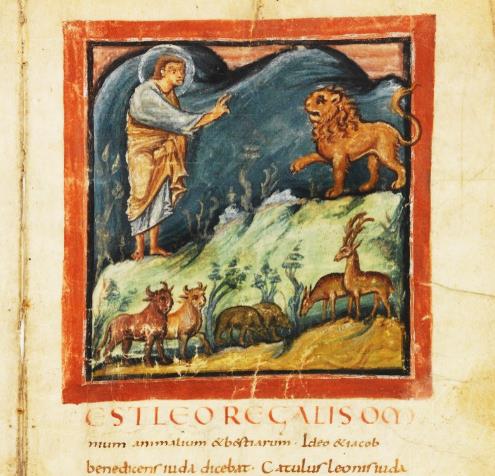
Jacob raises his hand in blessing as the Lion raises his paw, Physiologus, Bern Burgerbibliotek 318, fol 7r (c. 830 AD) https://www.ecodices.unifr.ch/en/bbb/0318/7r CC BY-NC 4.0
More on the Lion
Well, as David Badke points out, this chapter is ‘complex’ – indeed it is meaty, full of allegory, and with that initial wonderful opening alignment of the Lion with kingship – used by so many medieval rulers, including kings of England, despite the heraldic definition of their shields bearing ‘leopards’ rather than lions. Royal heraldry made lions the royal beast par excellence, and that link between kingship and lions was also made manifest in royal menageries, such Henry III’s one at the Tower of London where lions were kept. A medieval lion skull was found in the Tower of London’s moat. Of course, the Lion was initially linked to the King of Heaven which made the link to sacral authority even more necessary for medieval kingship. Yet as the Lion roared in the desert, it was also interpreted as a figure for the Devil (1 Peter 5:8). The allegory was dependent on context but, in the main, the Lion remained a figure for kingship, strong and fierce (afraid, like St Peter, only of cockcrow) and merciful to the penitent – an animal tale of perfect sovereignty.
Where to begin?
The Latin passage will normally be provided fortnightly on a separate sheet if posted to you or as a separate file on-line, so you can have the images, notes, and tips next to the translation, rather than overleaf. See that we have added line numbers in the left-hand margin so you can find a reference quickly. Lined paper and a pencil might be useful. By the way, it is absolutely fine to crib, medieval scribes did it all the time. As per Lewis Carroll, we start at the beginning of each chapter: here are notes and tips for the first chapter on the Lion.
I. De natura leonis, bestiarum seu animalium regis. translates as Chapter 1: About the nature of the Lion, King of the Beasts or Animals
Notes & Tips
1. How do you know Leonis means of the Lion? See this handy online dictionary called Logeion https://logeion.uchicago.edu/serra type in Leonis and see Leo/ Leonis is a masculine noun meaning Lion. If you click on DMLBS you will be taken to information from the Dictionary of Medieval Latin from British Sources.
2. To find out more about the medieval Bestiary Lion, please search Google for ‘bestiary.ca lion’ and this will bring you to the Canadian bestiary website hosted by David Badke – http://bestiary.ca/beasts/beast78.htm with information and translations from other medieval versions of the Bestiary and with some beautiful (and weird) images of the Lion.
3. If you are new or unconfident in your Latin, here’s a neat trick – copy the Latin phrase troubling you into William Whitaker’s Words https://archives.nd.edu/words.html Latin to English box and press enter on your keyboard. A new screen will open and tell you the possible meanings and possible grammar – e.g., the tense of a verb or the case of a noun.
4. Please use the Douay-Rheims English translation of the medieval Vulgate Bible although look at other translations for inspiration at will. https://www.biblegateway.com/quicksearch/?quicksearch=Lion&version=DRA
5. Using the translations: Our translations will be used as a basis for storytelling, including stories for families with special needs children and who we hope will be inspired to tell their own medieval animal tales. Think how the medieval Lion is called the King of the beasts – something we still hold now – for example, Disney uses the phrase the ‘Lion King.’
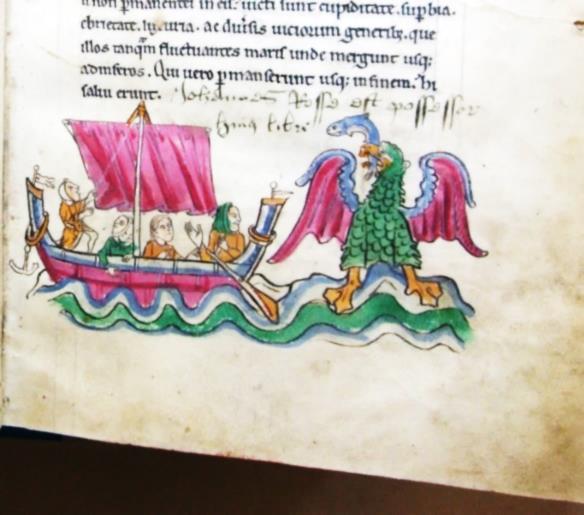
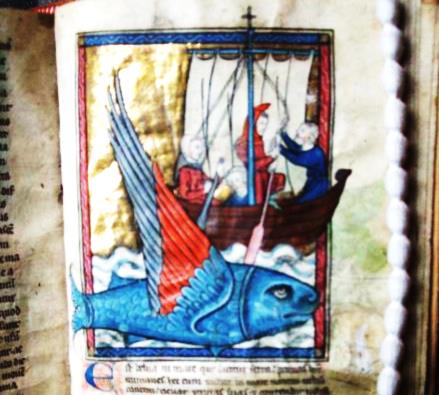
Translation of the previous chapter:
Chapter 4: About the Sawfish
1. The is a sea-monster called the Sawfish, which has enormous wings. 3 [f. 134a = manuscript ref]
2. When it sees a ship making sail at sea it raises 4
3. its wings [above the water] and competes with the ship. However, when it tries
4. to run with the ship for 30 or 40 furlongs [about 4 miles] it cannot
5. keep up and lowers its wings and draws them into itself; and from there they carry it back down
6. to where it came from in the depths of the sea. 5
7. Now the sea is a figure for this age. The ships provide an example of the righteous [people],
8. who, free from danger to or shipwreck of their faith, pass through
9. the middle of the storms and tempests of this world and overcome the deadly
10. waves which stand for the adverse forces of this time. Yet the Sawfish, that is
11. the monster which wished to sail against the ships, represents those
12. who at first engage in good works, but who
13. do not persevere with them and are overcome by ‘greed, pride,
14. drunkenness, licentiousness, and other kinds of vices’ which plunge them, as it were tossed by the sea, down to hell, ‘To those who persevere,6
16. is the reward promised.’ (Matth. 24:13)*
* The Douay-Rheims translation of the Vulgate Bible from Bible Gateway has https://www.biblegateway.com/passage/?search=Matthew+24&version=DRA but note this is not quite the same as the Latin text in the chapter. Literally, ‘Indeed, those who will have persevered to the end will be saved.
3 The sea-monster Serra might be based on reports of sawfish or carpenter sharks or flying fish, or marlins or swordfish. Pennas is traditionally translated as ‘wings’ in bestiaries but Pliny used the word to refer to a fin.
4 Viderit is the future perfect, literally, ‘will have seen.’
5 Literally, ‘to its original position ‘from where of the sea.’ Unde is an adverb meaning from where or from which, maris is genitive: of the sea.
6 Literal translation ‘will have persevered,’ i.e., the future perfect tense.


